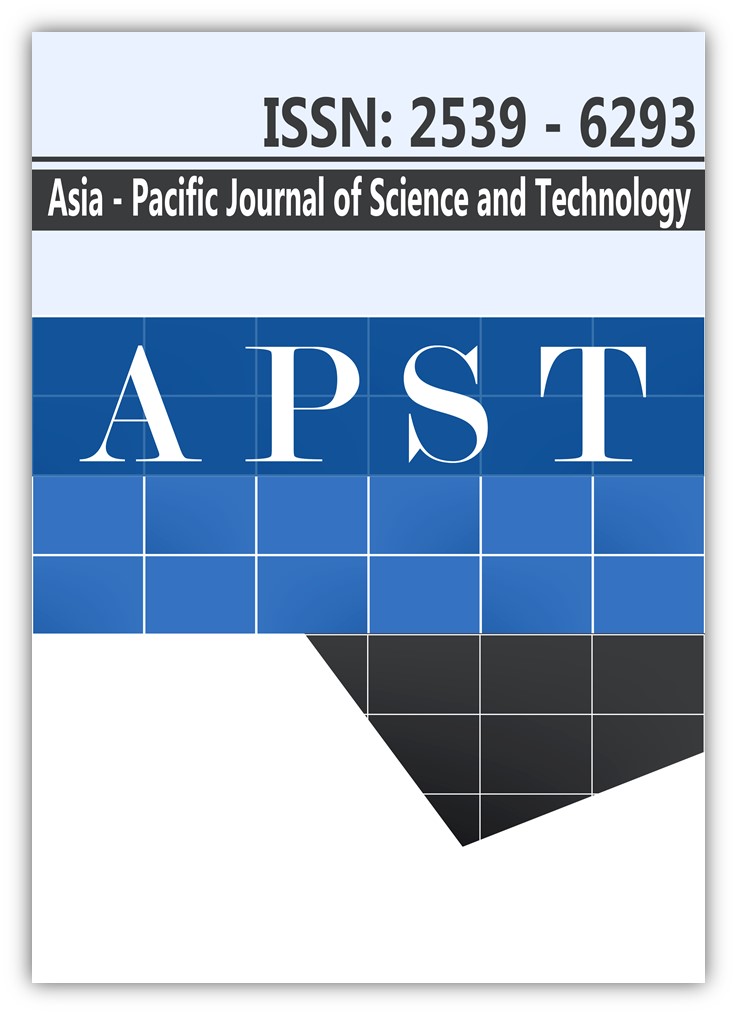A novel fungus, Mycodomus formicartus associated with black ant, Dolichoderus thoracicus (Smith) on bamboo
Main Article Content
Abstract
A fungus on a bamboo plant in Dan Sai district, Loei province, Thailand was collected for identification. Its appearance consisted of a grey-to-black matter with pores on the surface attached on a bamboo branch, and a population of black ants, Dolichoderus thoracicus (Smith) was associated with this fungus. Inside its fruiting body, there was a cavity functioning as a nest. With very dense hyphal mass, perithecia with periphyses were produced below the surface of the fruiting body. Asci contained 8 partascospores. The phylogenetic trees using three DNA regions, 18s rDNA, 28s rDNA and internal transcribed spacer suggested that it was in Dothideomycetes, Capnodiaceae but did not fit in any reported genus. Therefore, a new genus Mycodomus and species, Mycodomus formicartus were proposed and described.
Article Details
References
[2] Dai D, Bhat JD, Liu J, Chukeatirote E, Zhao R, Hyde KD. Bambusicola, a new genus from bamboo with asexual and sexual morphs. Cryptogam Mycol. 2012;33(3):363-379.
[3] Suetrong S, Hyde KD, Zhang Y, Bahkali AH, Jones EBG. Trematosphaeriaceae fam. nov. (Dothideomycetes, Ascomycota). Cryptogam Mycol. 2011;32(4):343-358.
[4] Voglmayr H, Mayer V, Maschwitz U, Moog J, Djieto-Lordon C, Blatrix R. The diversity of ant-associated black yeasts: insights into a newly discovered world of symbiotic interactions. Fungal Biol. 2011;115(10):1077-1091.
[5] Schlick-Steiner BC, Steiner FM, Konrad H, Seifert B, Christian E, Moder K, et al. Specificity and transmission mosaic of ant nest-wall fungi. Proc Natl Acad Sci. 2008;105(3):940-943.
[6] White TJ, Bruns T, Lee S, Taylor J. Amplification and direct sequencing of fungal ribosomal RNA genes for phylogenetics. PCR Protoc. 1990;315-322.
[7] O’Donnell K. Fusarium and its near relatives. In: Reynolds DR, Taylor JW, editors. The fungal holomorph: mitotic, meiotic and pleomorphic speciation in fungal systematics. Wallingford: CAB International; 1993. p. 225-233.
[8] Tamura K, Stecher G, Peterson D, Filipski A, Kumar S. MEGA6: Molecular evolutionary genetics analysis Version 6.0. Mol Biol Evol. 2013;30(12):2725-2729.
[9] Swofford DL. PAUP. Phylogenetic analysis using parsimony (and other methods). Version 4.0b10. Evolution. Sunderland MA. USA: Sinauer Associates; 2002.
[10] Felsenstein J. Confidence limits on phylogenies: An approach using the bootstrap. Evolution (N Y). 1985;39(4):783-791.
[11] Huelsenbeck JP, Ronquist F. MRBAYES: Bayesian inference of phylogenetic trees. Bioinformatics. 2001;17(8):754-755.
[12] Spatafora JW, Sung GH, Sung JM, Hywel- Jones NL, White JF. Phylogenetic evidence for an animal pathogen origin of ergot and the grass endophytes. Mol Ecol. 2007;16(8):1701-1711.
[13] Smith F. Descriptions of new species of Hymenopterous insects from the ilands of Sumatra, Sula, Gilolo, Salwatty, and New Guinea, collected by Mr. A. R. Wallace. J Proc Linn Soc London Zool. 1865;8(30):61-94.
[14] Shattuck SO. Taxonomic catalog of the ant subfamilies Aneuretinae and Dolichoderinae (Hymenoptera: Formicidae). Univ Calif Publ Entomol. 1994;112:1-241.
[15] Cuc NTT, Van Mele P. Beneficial effects of black ants (Dolichoderus thoracicus Smith) in sapodilla production in Vietnam. Biol Control Trop. 1999; 29-33.
[16] Liu Y, Liu Z, Wongkaew S. Developing characteristics and relationships of Shiraia bambusicola with bamboo. Songklanakarin J Sci Technol. 2012;34(1):17-22.
[17] Minter DW, Peredo HL, Watson AT. Acrospermum chilense sp. nov. from Chile and the Acrospermales ord. nov. Bol Soc Argent Bot. 2007;42:107-112.
[18] Ju YM, Rogers JD, San Martín F. A revision of the genus Daldinia. Mycotaxon. 1997;61:243-293.
[19] Whalley MA, Khalil AMA, Wei TZ, Yao YJ, Whalley AJS. A new species of Engleromyces from China, a second species in the genus. Mycotaxon. 2010;112:317-323.
[20] Bischoff JF, Chaverri P, White JF. Clarification of the host substrate of Ascopolyporus and description of Ascopolyporus philodendrus sp. nov. Mycologia. 2005;97(3):710-717.
[21] Chaverri P, Liu M, Hodge KT. A monograph of the entomopathogenic genera Hypocrella, Moelleriella, and Samuelsia gen. nov. (Ascomycota, Hypocreales, Clavicipitaceae), and their aschersonia-like anamorphs in the Neotropics. Stud Mycol. 2008;60:1-66.
[22] Bischoff JF, White JF. The plant-infecting clavicipitaleans. In: White J.F., Bacon C.W., Hywel-Jones N.L. SJW, editor. Clavicipitalean Fungi: evolution, biology, chemistry, biocontrol, and cultural impacts. 2003. p. 119-145.
[23] Way MJ, Khoo KC. Colony dispersion and nesting habits of the ants, Dolichoderus thoracicus and Oecophylla smaragdina (Hymenoptera: Formicidae), in relation to their success as biological control agents on cocoa. Bull Entomol Res. 1991;81(3):341-350.
[24] Fernández-Marín H, Zimmerman JK, Rehner SA, Wcislo WT. Active use of the metapleural glands by ants in controlling fungal infection. Proceedings Biol Sci. 2006;273(1594):1689-1695.
[25] Chomnunti P, Schoch CL, Aguirre–Hudson B, Ko-Ko TW, Hongsanan S, Jones EBG, et al. Capnodiaceae. Fungal Divers. 2011;51(1):103.


